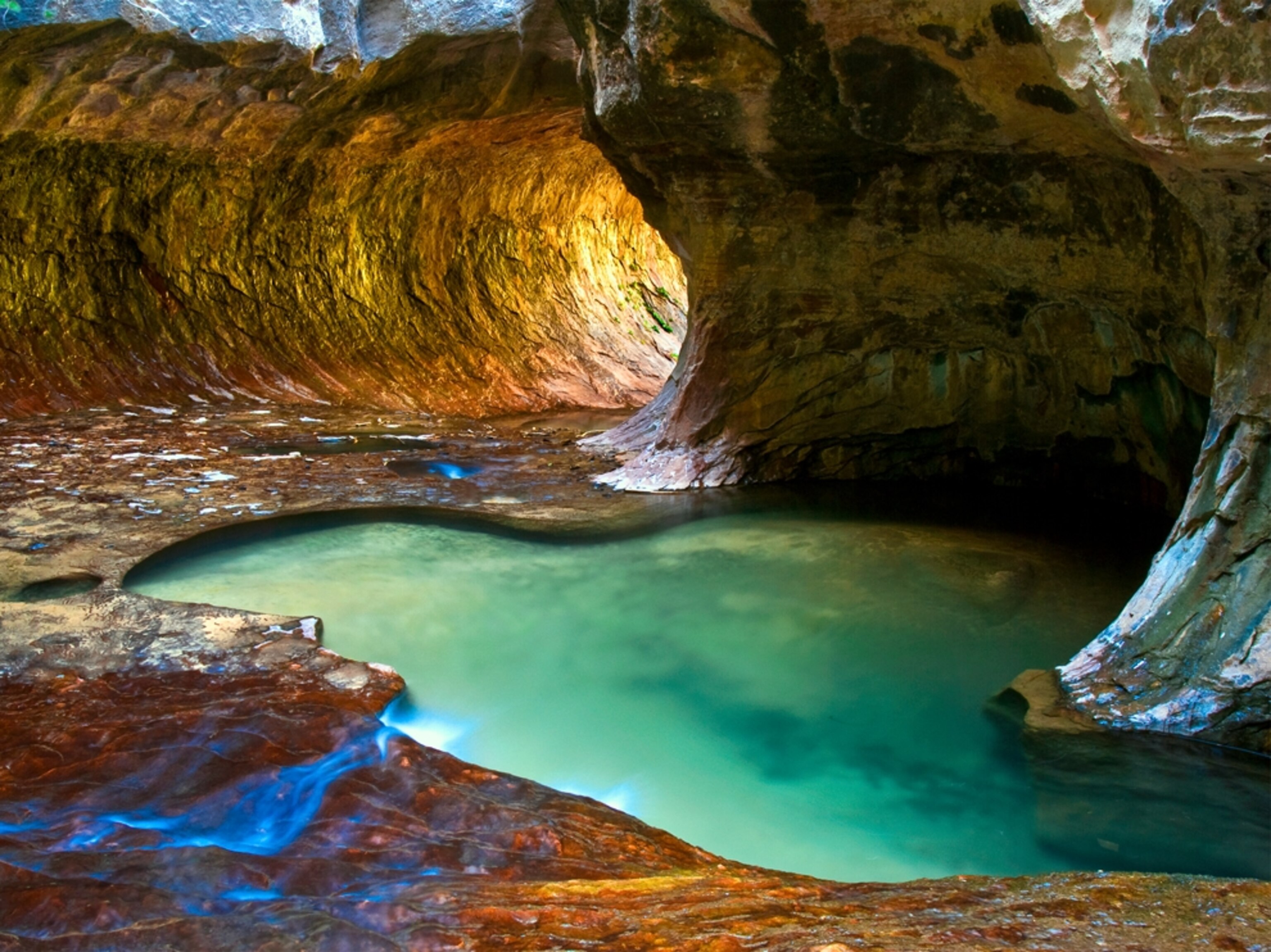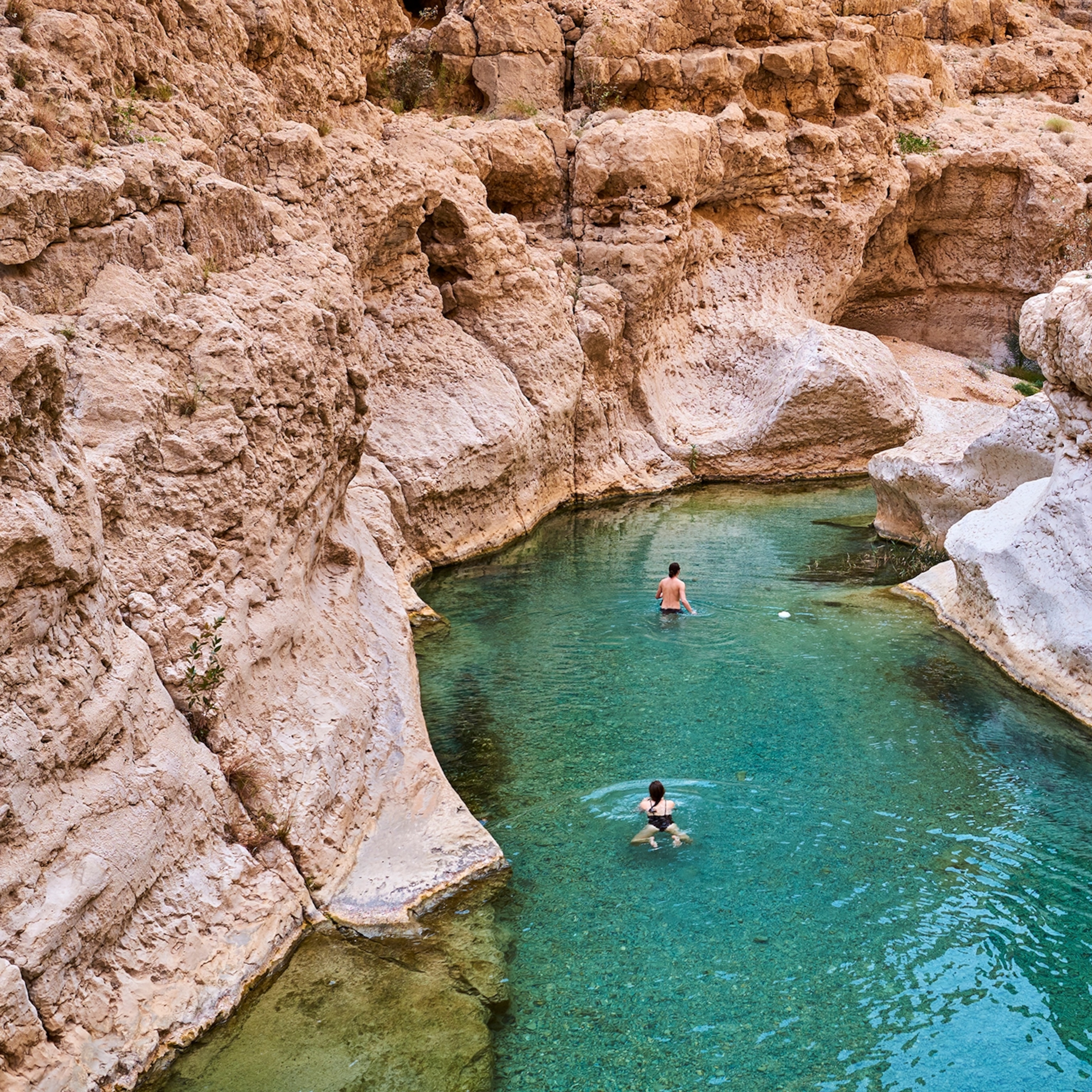
Playing the Slots
Unbound
From the May/June 2010 issue of National Geographic Traveler
Stepping over the edge is always a gamble, but in Zion National Park, the payoff is worth it.
As the stench of burning flesh fills my nostrils, I think, "This is supposed to be a vacation, not a back country version of Apocalypse Now." Unlike the Robert Duvall character in that Vietnam War flick who delighted in the smell of napalm in the morning, I don't fancy this particular odor—especially since it's my own flesh that is burning. It smells not like victory, but like, at minimum, a dozen broken bones, or, at worst, a premature encounter with my own obituary. I'm on a rope, rappelling down a hundred-foot cliff. Correction: I was rappelling for the first 20 feet. Now, I'm plummeting. Granted, there's no napalm, just friction, enough to melt the skin on my hands. My futile attempt to arrest my fall by squeezing harder on the rope is giving an ironic meaning to the term death grip. I wonder why I can't stop—and how I got into this mess.
The how part is easy. Eight friends—four couples—and I have gathered in southwestern Utah for a canyoneering vacation in Zion National Park. This increasingly popular adventure sport combines hiking, climbing, boulder scrambling, rappelling, swimming—really, whatever it takes—to navigate into, through, and out of deep, roadless, narrow canyons referred to as slots. The Zion area, a massive sandstone labyrinth where you can canyoneer for two weeks without repeating a route, is ideal. We've signed up for three days of life threatening fun.
Seven in our group have never canyoneered nor even strapped themselves into a climbing harness, so they spend a day with Zion Rock & Mountain Guides learning to rappel. I, Mr. Expert, Mr. I've-Done-This-Many-Times-and-Know-What-I'm-Doing, skip the training session and head out for a day of serious technical canyoneering with Mike Watters.
Watters is the short answer to the question of how I got into this mess. He's the one in our group who planned the trip, enticing us with photos and saying, "I can take you to the most spectacular place in all of Zion." Only after we were in the canyon did he tell us: "There's only one way out—the long, hard way."
Why I, and the others, would take adventure advice from a retired software executive relates to our mutual disdain for seeing the world only from a golf cart. Six years ago we met on a large group tour and bonded instantly, realizing we all shared a taste for adventure. Two or three times every year since, the four couples travel together for a bit of exotic sightseeing and a little kayaking, hiking, water skiing, snow skiing, or gorilla trekking. They take turns picking the destination and sometimes they invite me along. This trip was Watters's choice.
That is why he and I are now standing on the canyon rim at Birch Hollow, and I'm asking, "Is a hundred feet of rope enough?" The last thing you want when you rappel is to run out of rope before you reach the ground. Almost a dozen major rappels are ahead of us today, and on most of them we won't see the bottom from the top. In those cases, the all-important question of "How far could I fall?" can only be answered by a detailed map or an experienced guide. Our guide, Greg Istock, assures us that we have plenty of rope for what's coming.
Over millions of years, wind and water have carved the various types of red and yellow sandstone around Zion into natural sculptures that would put Michelangelo to shame. Around every twist and turn, another surprise awaits as the walls bend and curve into geometric patterns, colors subtly shift, and canyon walls unexpectedly widen or narrow, sometimes squeezing down to less than a shoulders' width apart. Be sure to check the forecast before venturing into one of these canyon cathedrals. In a rainstorm, a deadly flash flood can instantly explode through the serene setting, sweeping away trees, rocks, and people like so much helpless flotsam.
Even in dry weather, pools of freezing water get trapped in rocky basins in the slot canyons. The water can vary from ankle deep to over your head. Wearing a wet suit is recommended to combat the chilly water. Mike and I opt for an even warmer dry suit. What's not recommended is getting your photo taken in a dry suit. The outfit is bulky, big enough to pull on over your clothes, with tight rubber seals at the ankles, wrists, and neck. The suit traps air inside, helping you float in deep water. Completing the ensemble, our dry suits are also school-crossing-guard yellow. Over 12 hours, after surviving Birch Hollow, we work our way through Orderville Canyon into the Zion Narrows. We emerge from the river near the shuttle stop in Zion National Park. We board the shuttle with other tourists, who are in tank tops and flip-flops. Still wearing our dry suits, we must look to them like something from another planet. Indeed, all of us have been in the same park, but our memories of the day are worlds apart.
Day three of our canyoneering adventure, our group assembles at Wildcat Canyon trailhead with the goal of descending into Russell Gulch and proceeding along the Left Fork of North Creek to arrive at what I consider one of the most beautiful spots in the park, if not the world: the Subway. Frankly, I'm a bit surprised we're all still here and game for the challenge. We'll have no guides. We know it will be a long day, at least 12 hours. We'll have to climb down some very steep walls, swim in cold water in our uncomfortable dry suits, and, perhaps most ominously, do some big rappels. Thus far no one but me, Mr. I-Don't-Need-a-Training-Session, has had a problem on the rope, but everyone is fully aware of what could go wrong—all were present on the previous day's three-hour practice hike, when I took my fall.
- National Geographic Expeditions
We still don't know why I fell, but there is no doubt about how I stopped. Istock, our guide, who was already at the bottom, realized I was in serious trouble and pulled hard on the end of the rappel rope, bringing me to a complete stop before I buried myself in the canyon floor. The group saw the fall and my scorched fingers and palms, and yet here they are, undeterred, ready to take on this more serious challenge of the Subway.
Luckily, on this final day of canyoneering, there are no mishaps, only rewards. Even with my hands taped and gloved, I'm finding this one of the best days I've ever spent in a national park. It is time shared with friends committed to never settling for the ordinary or taking the easy route when they can go deeper into a travel experience. Maybe friendships, like steel, are stronger when forged by fire.
And, as I had hoped, you can share some tea and listen to climbing war stories in the shadow of the mountain where the battles took place.







